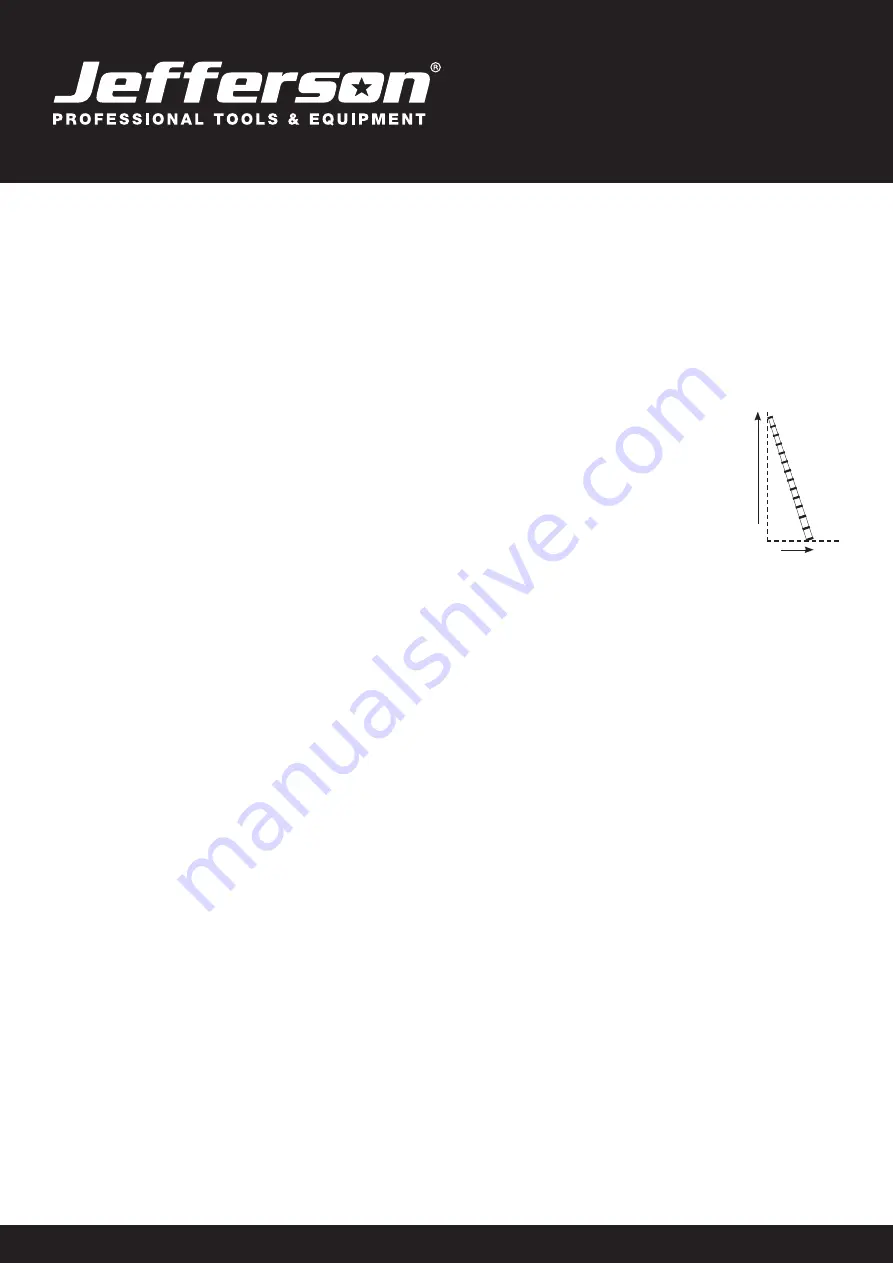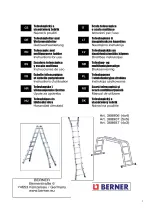
www.jeffersontools.com
User Manual
v.1.1
JEFLADTEL10
1. SAFETY
WARNING:
PLEASE READ THESE INSTRUCTIONS CAREFULLY
AND KEEP FOR FUTURE REFERENCE
1.1.
Identify any electrical risks in the work area, such as overhead lines or other exposed electrical equipment.
1.2.
This ladder does not offer insulation or protection from electrical hazards.
1.3.
The ladder shall be only be positioned flat on its feet, not the rungs or steps.
1.4.
Never position or use the ladder on slippery surfaces (such as ice, shiny surfaces or significantly contaminated solid surfaces)
unless additional effective measures are taken to prevent the ladder slipping or ensuring contaminated surfaces are sufficiently clean.
1.5.
The ladder shall be erected at the correct position, such as the correct angle for a leaning ladder (angle of inclination approximately 1:4)
with the rungs or treads level (e.g.
1m away from the base of a wall if extending to climb 4m up (see fig.A)
).
1.6.
Always position the ladder against a flat, non-fragile surface and secure properly before use e.g. tied down or with the
use of a suitable stability device.
1.7.
The locking mechanisms for all the extended rung sections shall be locked before using the ladder.
1.8.
Never attempt to move or reposition the ladder from above.
1.9.
The Jefferson 2.9M Telescopic Ladder is constructed from a lightweight aluminium alloy for a strong and portable
climbing solution for domestic use.
1.10. Extends and locks rung by rung to reach the perfect level with secure locking tabs for smooth and responsive adjustment.
BEFORE USE
1.11. Before using the ladder it shall be checked that all locking mechanisms are working properly.
If the mechanism is not working properly, do not use the ladder.
1.12. Wear tight-fitting clothing, remove jewellery and tie long hair back when using the ladder.
1.13. Always wear suitable footwear when climbing a ladder; flat, dry, treaded, shoes with securely tied laces are
considered appropriate footwear.
1.14. Ensure that the surface you will rest the ladder against is capable of supporting the combined weight of the ladder,
operator and any carried objects.
1.15. Doors (but not fire doors or similar), windows and areas of entry/exit should be secured when using the ladder.
1.16. All distractions should be reasonably avoided. Always set up the Telescopic Ladder so that it is always freely accessible.
1.17. When transporting ladders on roof bars or in a truck, ensure they are suitably placed and secured to prevent damage.
1.18. The ladder shall be inspected after delivery and before every use to confirm condition and operation of all parts.
Use the checklist provided in the ‘Before Use: Risk Assessment’ section of this manual.
1.19. Visually check that the ladder is not damaged and is safe to use at the start of each working day when the ladder is to be used.
1.20. Remove any contamination from the ladder, such as wet paint, mud, oil or snow.
1.21. For professional users, regular periodic inspection is required.
1.22. Before using a ladder at work, a risk assessment should be carried out respecting the legislation in the country of use.
1.23. Ensure the ladder is suitable for the task. If unsure, contact a qualified person for guidance.
1.24. Do not use a damaged or otherwise unsuitable ladder.
USING THE LADDER
1.25. Do not exceed the maximum total load of 150kg/330lbs for this ladder.
1.26. Only allow one person to use the ladder at any time.
1.27. Ladders should only be used for light work of short duration.
1.28. Use non-conductive ladders for unavoidable live electrical work. This ladder is not suitable for live electrical work as it is
conductive and offers no protection from electrical hazards.
1.29. Never erect or use the ladder upside down. The base should always sit firmly on the ground.
1.30. Do not use the ladder outside in adverse weather conditions, such as strong wind or rain.
1.31. Do not leave an extended ladder unattended.
1.32. Take precautions against children playing on the ladder.
1.33. Do not place any tools or other objects on the rungs and do not hang anything on the ladder system.
1.34. Equipment carried while using a ladder should be light and easy to handle.
1.35. Face the ladder and keep a secure grip when ascending and descending.
1.36. Do not slide down the stiles of the ladder.
1.37. Climb and descend with deliberate movements.
1.38. Always maintain 3 points of contact with the ladder at all times e.g. two feet on the same rung and a hand on the stiles.
1.39. Use additional safety equipment if this is not possible.
1.40. Maintain a handhold whilst working from a ladder or take additional safety precautions if you cannot.
1.41. Do not overreach; always keep your belt buckle (navel) inside the stiles and both feet on the same step/rung throughout the task.
1.42. Avoid work that imposes a sideways load on ladders, such as side-on drilling through solid materials (e.g. brick or concrete).
1.43. In the leaning ladder position it is not allowed to climb higher than last metre of the ladder.
1.44. The user shall put the hands around the stile when bringing the ladder from extendedto storage position.
1.45. Do not stand on the top three rungs on the ladder; this can cause stability issues.
1.46. Do not use the ladder as a bridge.
1.47. Leaning ladders used for access to a higher level should be extended at least 1m above the landing point
1.48. Do not step off a leaning ladder at a higher level without additional security, such as tying off or use of a suitable stability device.
1.49. Do not step off the side of the ladder.
1m
4m
(Fig.A)














